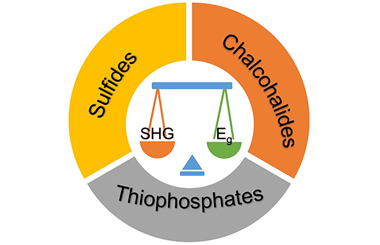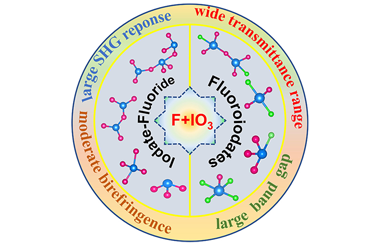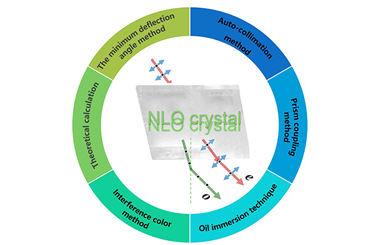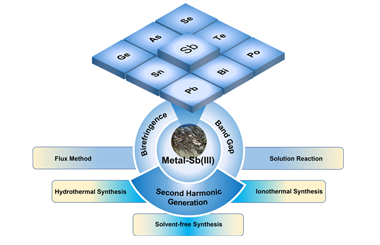
Tao Ouyang, Yaoguo Shen*, Sangen Zhao
-
Guest EditorialSpecial Issue for Nonlinear Optical Crystals
Sangen Zhao*, Guohong Zou*, Min Zhang*, Hongwei Yu*, Xingxing Jiang*, Min Luo*
January 15, 2023
ABSTRACT
Nonlinear optical (NLO) crystals can efficiently convert the frequency of common solid-state laser with fixed or limited wavelengths. Since the first observation of second-harmonic generation (SHG) phenomenon in the early 1960s, they have played an increasing role in the fields of laser spectra, precision measurements, and quantum information, as well as industrial laser processing, and so on. However, it is still challenging to rationally design and synthesize new NLO crystals.
-
Short CommunicationFrom Cs8Sb4Nb5O5F35 to Cs6Sb4Mo3O5F26: The first noncentrosymmetric fluoroantimonite with d0 transition metal
Jia-Hang Wu, Bo Zhang, Ting-Kun Jiang, Fang Kong*, Jiang-Gao Mao
Chin. J. Struct. Chem., 2023, 42: 100016 DOI: 10.1016/j.cjsc.2023.100016
January 15, 2023
ABSTRACT
The first noncentrosymmetric d0 TM fluoroantimonate, Cs6Sb4Mo3O5F26, has been achieved by substituting the d0 TM in centrosymmetric Cs8Sb4Nb5O5F35. Cs6Sb4Mo3O5F26 features a phase-matchable SHG response of about 72% of the commercial KDP. Its powder laser-induced damage threshold (133.5 MW/cm2) is about 33.4 times that of AGS (4.0 MW/cm2). -
Short CommunicationPolymorphism of LiCdBO3: Crystal structures, phase transitions and optical characterizations
Qingxiong Liu, Qian Wu*, Tianyu Wang, Lei Kang, Zheshuai Lin, Yonggang Wang, Mingjun Xia*
Chin. J. Struct. Chem., 2023, 42: 100026 DOI: 10.1016/j.cjsc.2023.100026
January 15, 2023
ABSTRACT
Three polymorphisms and two-step phase transitions of LiCdBO3 were investigated by the combination of powder X-ray diffraction, thermal analysis experimental techniques and the first principles calculations for the first time. The SHG switching was also achieved with a NLO switching contrast of about 625, indicating the potential applications in the sensors and optoelectronics. -
Article
Deep-ultraviolet nonlinear-optical crystal BaNa2[PO3(OH)]2 with large birefringence and strong second-harmonic-generation response
Yuanyu Yang, Yao Guo, Yi-Gang Chen*, Chengbo Li, Xian-Ming Zhang*
Chin. J. Struct. Chem., 2023, 42: 100015 DOI: 10.1016/j.cjsc.2023.100015
January 15, 2023
Nonlinear-optical, Birefringence, Structure, Phosphates, Optical properties
ABSTRACT
Deep-ultraviolet nonlinear-optical crystal BaNa2[PO3(OH)]2 featuring two-dimensional [NaPO3(OH)]∞ alveolate layers can realize a good balance of nonlinear properties. -
ArticleAIO3∙H6TeO6 (A = NH4+, Rb+): Two telluric acid and iodate Co-crystalline compounds with second harmonic generation response
Shunye Yu, Yi Shui, Shuo Liu, Gan Huang, Canxiao Huang, Chunhui Geng, Lili Liu, Hongming Liu*
Chin. J. Struct. Chem., 2023, 42: 100025 DOI: 10.1016/j.cjsc.2023.100025
January 15, 2023
Nonlinear optical, Co-crystalline, Isostructural, Local dipole moment, Second harmonic generation
ABSTRACT
The co-crystallization of telluric acid and iodate gives rise to two noncentrosymmetric crystals AIO3·H6TeO6 (A = Rb+, NH4+). They show different intensity of SHG responses due to the slight change of the orientation of [IO3] and [Te(OH)6] groups induced by different cations in A-site. -
ReviewRecent progress on sulfide infrared nonlinear optical materials with large SHG response and wide band gap
Linan Wang, Qi Sun, Junjie Li*
Chin. J. Struct. Chem., 2023, 42: 100013 DOI: 10.1016/j.cjsc.2023.100013
January 15, 2023
Infrared NLO materials, Sulfides, Tructure-property relationship, Optical property
ABSTRACT
In this review, the progress of high-performance sulfide IR NLO materials since 2018 has been highlighted, and 13 cases of chalcogenides with balanced optical properties of SHG (≥ 1.0 × AGS) and band gap (≥ 3.0 eV) have been summarized and discussed in detail. -
ReviewRecent advances in F-containing iodate nonlinear optical materials
Dong Gao, Hongping Wu, Zhanggui Hu, Jiyang Wang, Yicheng Wu, Hongwei Yu*
Chin. J. Struct. Chem., 2023, 42: 100014 DOI: 10.1016/j.cjsc.2023.100014
January 15, 2023
Mid-infrared, Nonlinear optical materials, Iodate-fluorides, Fluoroiodates
ABSTRACT
This paper summarizes the research achievements of F-containing NLO iodates reported until now, focusing on their crystal structures, NLO properties, and structure-property relationships. Meanwhile, various structure designing strategies for F-containing iodates with different valence center cations are also highlighted. -
ReviewEvaluating refractive index and birefringence of nonlinear optical crystals: Classical methods and new developments
Qi Shi, Lingyun Dong*, Ying Wang*
Chin. J. Struct. Chem., 2023, 42: 100017 DOI: 10.1016/j.cjsc.2023.100017
January 15, 2023
Nonlinear optical crystals, Refractive index, Birefringence, DFT calculation, Phase-matching
ABSTRACT
In this review, we describe how to obtain the refractive index and birefringence of NLO materials from crystals sub-millimeters to centimeters in size, and summarize the recently developed methods for rapid assessment of birefrin-gence. In addition, representative examples of birefringent measurements are also presented. -
Review
Compounds consisting of coplanar π-conjugated B3O6-typed structures: An emerging source of ultraviolet nonlinear optical materials
Lingli Wu, Huixin Fan, Chensheng Lin, Min Luo*
Chin. J. Struct. Chem., 2023, 42: 100019 DOI: 10.1016/j.cjsc.2023.100019
January 15, 2023
NLO crystals, B3O6-typed structures, π-conjugated, Anionic group theory
ABSTRACT
This review focuses on the NLO materials with B3O6-typed groups, and we roughly divide these groups into several categories, including cyanurates (HxC3N3O3)x−3 (x = 0–3), barbiturates (HxC4N2O3)x−4 (x = 2, 3), melamines (C3H7N6)+, (C5H6ON)+ and (C4H6N3)+ groups. -
ReviewRecent advances on the synthesis of Sb(III)-based inorganic ultraviolet nonlinear optical materials
Gangji Yi, Guohong Zou*
Chin. J. Struct. Chem., 2023, 42: 100020 DOI: 10.1016/j.cjsc.2023.100020
January 15, 2023
Ultraviolet nonlinear optical, Second harmonic generation, Synthetic methods, Sb(III)-based compounds
ABSTRACT
A brief summary on the synthesis of Sb(III)-based compounds is presented in this review, including flux method, solution reaction, hydrothermal synthesis, ionothermal synthesis and solvent-free synthesis. -
ReviewAccurate design and synthesis of nonlinear optical crystals employing KBe2BO3F2 as structural template
Tao Ouyang, Yaoguo Shen*, Sangen Zhao
Chin. J. Struct. Chem., 2023, 42: 100024 DOI: 10.1016/j.cjsc.2023.100024
January 15, 2023
Nonlinear optical materials, Borates, Microscopic crystal structure design, Beryllium-free
ABSTRACT
It is still very challenging to realize accurate design and synthesis of second-order nonlinear optical (NLO) crystals and evaluate the overall performance of new ultraviolet NLO materials. We, from the perspective of microscopic crystal structure based on KBBF, elaborate the accurate design and synthesis of high-performance NLO materials and analyse which atoms and groups can be replaced.

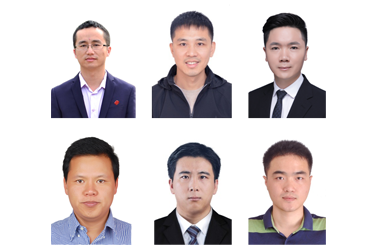
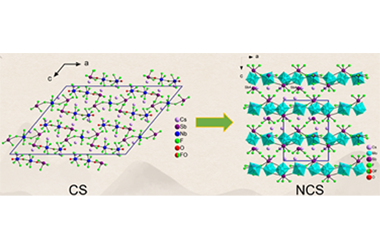
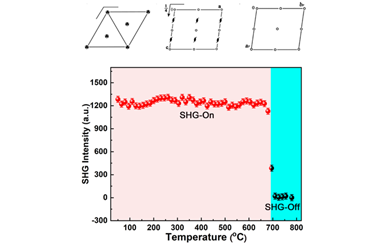
![Deep-ultraviolet nonlinear-optical crystal BaNa2[PO3(OH)]2 with large birefringence and strong second-harmonic-generation response 2023.100015 Deep-ultraviolet nonlinear-optical crystal BaNa2[PO3(OH)]2 with large birefringence and strong second-harmonic-generation response 2023.100015](/Site/default/Uploads/20230226/100015-3[1].png)

